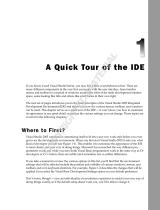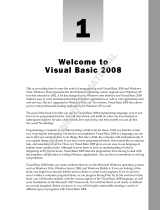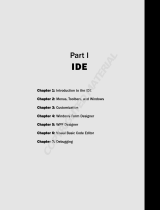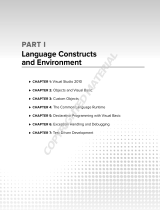Page is loading ...

Part I
Integrated
Development
Environment
Chapter 1: A Quick Tour
Chapter 2: The Solution Explorer, Toolbox, and Properties
Chapter 3: Options and Customizations
Chapter 4: Workspace Control
Chapter 5: Find & Replace, and Help
c01.indd 1c01.indd 1 6/20/08 3:13:59 PM6/20/08 3:13:59 PM
COPYRIGHTED MATERIAL

c01.indd 2c01.indd 2 6/20/08 3:14:00 PM6/20/08 3:14:00 PM

A Quick Tour
Ever since we have been developing software, there has been a need for tools to help us write,
compile, and debug our applications. Microsoft Visual Studio 2008 is the next iteration in the
continual evolution of a best - of - breed integrated development environment (IDE). If this is your
first time using Visual Studio, then you will find this chapter a useful starting point. Even if you
have worked with a previous version of Visual Studio, you may want to quickly skim it.
This chapter introduces the Visual Studio 2008 user experience and will show you how to work
with the various menus, toolbars, and windows. It serves as a quick tour of the IDE, and as such it
won ’ t go into detail about what settings can be changed or how to go about customizing the
layout, as these topics will be explored in the following chapters.
Let ’ s Get Started
Each time you launch Visual Studio you will notice the Microsoft Visual Studio 2008 splash screen
appear. Like a lot of splash screens, it provides information about the version of the product and to
whom it has been licensed, as shown in Figure 1 - 1 .
Figure 1-1
c01.indd 3c01.indd 3 6/20/08 3:14:00 PM6/20/08 3:14:00 PM

Part I: Integrated Development Environment
4
More importantly, the Visual Studio splash screen includes a list of the main components that have been
installed. If you install third - party add - ins, you may see those products appear in this list.
The first time you run Visual Studio 2008, you will see the splash screen only for a short period before
you are prompted to select the default environment settings. It may seem unusual to ask those who
haven ’ t used a product before how they imagine themselves using it. As Microsoft has consolidated a
number of languages and technologies into a single IDE, that IDE must account for the subtle (and
sometimes not so subtle) differences in the way developers work.
If you take a moment to review the various options in this list, as shown in Figure 1 - 2 , you ’ ll find that the
environment settings that will be affected include the position and visibility of various windows, menus,
and toolbars, and even keyboard shortcuts. For example, if you select the General Development Settings
option as your default preference, this screen describes the changes that will be applied.
Figure 1-2
A tip for Visual Basic .NET developers coming from previous versions of Visual Studio is that they
should NOT use the Visual Basic Development Settings option. This option has been configured for
VB6 developers and will only infuriate Visual Basic .NET developers, as they will be used to different
shortcut key mappings. We recommend that you use the general development settings, as these will use
the standard keyboard mappings without being geared toward another development language.
c01.indd 4c01.indd 4 6/20/08 3:14:00 PM6/20/08 3:14:00 PM

Chapter 1: A Quick Tour
5
The Visual Studio IDE
Depending on which set of environment settings you select, when you click the Start Visual Studio
button you will most likely see a dialog indicating that Visual Studio is configuring the development
environment. When this process is complete, Visual Studio 2008 will open, ready for you to start work,
as shown in Figure 1 - 3 .
Figure 1-3
Regardless of the environment settings you selected, you will see the Start Page in the center of the
screen. However, the contents of the Start Page and the surrounding toolbars and tool windows can vary.
At this stage it is important to remember that your selection only determined the default settings, and
that over time you can configure Visual Studio to suit your working style.
The contents shown in the right - hand portion of the Start Page are actually just the contents of an RSS
feed. You can change this to be your favorite blog, or even a news feed (so you can catch up on the latest
news while your solution is loading), by changing the news channel property on the Environment
Startup node in the Options dialog, accessible via the Options item on the Tools menu.
c01.indd 5c01.indd 5 6/20/08 3:14:01 PM6/20/08 3:14:01 PM

Part I: Integrated Development Environment
6
Before we launch into building our first application, it ’ s important that we take a step back and look at
the components that make up the Visual Studio 2008 IDE. Menus and toolbars are positioned along the
top of the environment (as in most Windows applications), and a selection of sub - windows, or panes,
appears on the left and right of the main window area. In the center is the main editor space: Whenever
you open a code file, an XML document, a form, or some other file, it will appear in this space for
editing. With each file you open, a new tab is created so that you can toggle among opened files.
On either side of the editor space is a set of tool windows: These areas provide additional contextual
information and functionality. In the case of the general developer settings, the default layout includes
the Solution Explorer and Class View on the right, and the Server Explorer and Toolbox on the left. The
tool windows on the left are in their collapsed, or unpinned, state. If you click on a tool window ’ s title, it
will expand; it will collapse again when it no longer has focus or you move the cursor to another area of
the screen. When a tool window is expanded you will see a series of three icons at the top right of the
window, similar to those shown in the left image of Figure 1 - 4 .
Figure 1-4
If you want the tool window to remain in its expanded, or pinned, state, you can click the middle icon,
which looks like a pin. The pin will rotate 90 degrees to indicate that the window is now pinned.
Clicking the third icon, the X, will close the window. If later you want to reopen this or another tool
window, you can select it from the View menu.
Some tool windows are not accessible via the View menu, for example those having to do with
debugging, such as threads and watch windows. In most cases these windows are available via an
alternative menu item: in the case of the debugging windows it is the Debug menu.
The right image in Figure 1 - 4 shows the context menu that appears when the first icon, the down arrow,
is clicked. Each item in this list represents a different way of arranging the tool window. In the left image
of Figure 1 - 5 the Solution Explorer is set as dockable, whereas in the right image the floating item has
been selected. The latter option is particularly useful if you have multiple screens, as you can move the
various tool windows onto the additional screen, allowing the editor space to use the maximum screen
real estate. Selecting the Tabbed Document option will make the tool window into an additional tab in
the editor space. In Chapter 4 you will learn how to effectively manage the workspace by docking and
pinning tool windows.
c01.indd 6c01.indd 6 6/20/08 3:14:01 PM6/20/08 3:14:01 PM

Chapter 1: A Quick Tour
7
Figure 1-5
The other thing to note about the left image of Figure 1 - 5 is that the editor space has been divided into
two horizontal regions. If you right - click an existing tab in the editor space, you can elect to move it to a
new horizontal or vertical tab group. This can be particularly useful if you are working on multiple
forms, or if you want to view the layout of a form while writing code in the code - behind file.
In the right image of Figure 1 - 5 the editor space is no longer rendered as a series of tabs. Instead, it is a
series of child windows, in classic multiple - document - interface style. Unfortunately, this view is
particularly limiting, because the child windows must remain within the bounds of the parent window,
making it unusable across multiple monitors. To toggle between tabbed and multiple document window
layouts, simply select the Environment
General node from the Options dialog.
Develop, Build, and Debug Your First Application
Now that you have seen an overview of the Visual Studio 2008 IDE, let ’ s walk through creating a simple
application that demonstrates working with some of these components. This is, of course, the mandatory
“Hello World” sample that every developer needs to know, and it can be done in either Visual Basic
.NET or C#, depending on what you feel more comfortable with.
1. Start by selecting File New Project. This will open the New Project dialog, as shown in
Figure 1 - 6 . A couple of new features are worth a mention here. Based on numerous feedback
requests, this dialog is now resizable. More importantly, there is an additional drop - down box in
the top right - hand corner, which is used to select the version of the .NET Framework that the
application will target. The ability to use a single tool to create applications that target different
framework versions means that developers can use fewer products and can take advantage of
all the new features, even if they are maintaining an older product.
c01.indd 7c01.indd 7 6/20/08 3:14:02 PM6/20/08 3:14:02 PM

Part I: Integrated Development Environment
8
Figure 1-6
Select the Windows Forms Application from the Templates area (this item exists under the root
Visual Basic and Visual C# nodes, or under the sub - node Windows) and set the Name to
“ GettingStarted, ” before selecting OK. This should create a new windows application project,
which includes a single startup form and is contained within a “ GettingStarted ” solution, as
shown in the Solution Explorer window of Figure 1 - 7 . This startup form has automatically
opened in the visual designer, giving you a graphical representation of what the form will look
like when you run the application. You will notice that there is now an additional command bar
visible and that the Properties tool window is in the right tool windows area.
Figure 1-7
c01.indd 8c01.indd 8 6/20/08 3:14:02 PM6/20/08 3:14:02 PM

Chapter 1: A Quick Tour
9
2. Click on the Toolbox tool window, which will cause the window to expand, followed by the pin
icon, which will pin the tool window open. To add controls to the form, select the appropriate
items from the Toolbox and drag them onto the form. In Figure 1 - 8, you can see how the Toolbar
tool window appears after being pinned and the result of clicking and dragging a button onto
the form visual designer.
Figure 1-8
3. Add a button and textbox to the form so that the layout looks similar to the one shown in
Figure 1 - 9 . Select the textbox and select the Properties tool window (you can press F4 to
automatically open the Properties tool window). Use the scrollbar to locate the (
Name ) property
and set it to
txtToSay . Repeat for the button control, naming it btnSayHello and setting the
Text property to “ Say Hello! ”
Figure 1-9
c01.indd 9c01.indd 9 6/20/08 3:14:04 PM6/20/08 3:14:04 PM

Part I: Integrated Development Environment
10
4. When a form is opened in the editor space, an additional command bar is added to the top of
Visual Studio 2008. If you select both controls on the form, you will see that certain icons on this
command bar are enabled. Selecting the Make Same Width icon will align the edges of the two
controls, as illustrated in Figure 1 - 10 .
You will also notice that after you add controls to the form the tab will be updated with an
asterisk (
* ) after the text to indicate that there are unsaved changes to that particular item. If you
attempt to close this item while changes are pending, you will be asked if you want to save the
changes. When you build the application, any unsaved files will automatically be saved as part
of the build process.
One thing to be aware of is that some files, such as the solution file, are modified when you make
changes within Visual Studio 2008 without your being given any indication that they have changed.
If you try to exit the application or close the solution, you will still be prompted to save these changes.
Figure 1-10
5. Deselect all controls and then double - click the button. This will not only open the code editor
with the code - behind file for this form; it will also create and wire up an event handler for the
Click Event on the button. Figure 1 - 11 shows the code window after we have added a single
line to echo the message to the user.
c01.indd 10c01.indd 10 6/20/08 3:14:05 PM6/20/08 3:14:05 PM

Chapter 1: A Quick Tour
11
Figure 1-11
6. The last step in the process is to build and execute the application. Before doing so, place the
cursor somewhere on the line containing
Messagebox.Show and press F9. This will set a
breakpoint — when you run the application by pressing F5 and then click the Say Hello! button,
the execution will halt at this line. Figure 1 - 12 illustrates this breakpoint being reached. The data
tip, which appears when the mouse hovers over the line, shows the contents of the
txtToSay
.ext
property.
Figure 1-12
The layout of Visual Studio in Figure 1 - 12 is significantly different from the previous
screenshots, as there are a number of new tool windows visible in the lower half of the screen
and new command bars at the top. When you stop the application you will notice that Visual
Studio returns to the previous layout. Visual Studio 2008 maintains two separate layouts: design
c01.indd 11c01.indd 11 6/20/08 3:14:05 PM6/20/08 3:14:05 PM

Part I: Integrated Development Environment
12
time and runtime. Menus, toolbars, and various windows have default layouts for when you are
editing a project, whereas a different setup is defined for when a project is being executed and
debugged. You can modify each of these layouts to suit your own style and Visual Studio 2008
will remember them.
It ’ s always a good idea to export your layout and settings (see Chapter 3 ) once you have them set up just
the way you like them. That way you can take them to another PC or restore them if your PC gets rebuilt.
Summary
You ’ ve now seen how the various components of Visual Studio 2008 work together to build an
application. As a review of the default layout for Visual Basic programs, the following list outlines the
typical process of creating a solution:
1. Use the File menu to create a solution.
2. Use the Solution Explorer to locate the form that needs editing and click the View Designer
button to show it in the main workspace area.
3. Drag the necessary components onto the form from the Toolbox.
4. Select the form and each component in turn, and edit the properties in the Properties window.
5. Use the Solution Explorer to locate the form and click the View Code button to access the code
behind the form ’ s graphical interface.
6. Use the main workspace area to write code and design the graphical interface, switching
between the two via the tabs at the top of the area.
7. Use the toolbars to start the program.
8. If errors occur, review them in the Error List and Output windows.
9. Save the project using either toolbar or menu commands, and exit Visual Studio 2008.
While many of these actions can be performed in other ways (for instance, right - click the design surface
of a form and you ’ ll find the View Code command), this simplified process shows how the different
sections of the IDE work in conjunction with each other to create a comprehensive application design
environment.
In subsequent chapters, you ’ ll learn how to customize the IDE to more closely fit your own working
style, and how Visual Studio 2008 takes a lot of the guesswork out of the application development
process. You will also see a number of best practices for working with Visual Studio 2008 that you can
reuse as a developer.
c01.indd 12c01.indd 12 6/20/08 3:14:06 PM6/20/08 3:14:06 PM
/








